How To Install Automatic Gas Shut Off Valve
Automatic Gas Shutoff Valves
Scope
In homes that are equipped with a gas line that runs from the utility line to the dwelling house, install an automatic gas shutoff valve that shuts off the menses of natural gas to a habitation in the consequence of an earthquake or line rupture, if required by local building lawmaking or requested by the homeowner if required past the homeowner's insurance company or desired by the homeowner for peace of mind. There are 2 types of automatic gas shutoff valves: seismic (or earthquake-actuated) valves and excess catamenia valves. Seismic gas shutoff valves (also called earthquake valves) close off the flow of gas from the meter to the house if globe move equivalent to about 5.iv or more on the Richter scale is detected. Excess flow valves stop the flow of gas from the street to the meter if backlog flow or loss of force per unit area is detected, indicating a potential rupture of the gas line due to any crusade (construction, earthquake, other natural disaster, tree roots, etc.).
- Decide whether the homeowner desires or is required by local ordinance to install a seismic valve and/or an excess flow valve.
- Select a model that is approved in your jurisdiction and install in accordance with local ordinances.
- Seismic valves are installed on the homeowner'southward side of the meter past a licensed plumber or the homeowner.
- Backlog catamenia valves are installed on the utility side of the meter by the utility.
See the Compliance Tab for related codes and standards requirements, and criteria to meet national programs such as DOE's Cipher Energy Prepare Domicile program, Energy STAR Certified Homes, and Indoor airPLUS.
Description
Homes that are equipped with a gas line that runs from the utility line to the home should take an automatic gas shut-off valve (ASV) (Figure 1), which is a valve that shuts off the flow of gas into a home due to an earthquake or other issue that causes a rupture of the gas line, thus reducing the take chances of explosion or fires from leaking gas. Shaking or movement of a building or the appliances in the home in the event of an earthquake or other natural disaster can cause damage to the gas piping and appliances, causing the accidental release of natural gas, which tin can atomic number 82 to fires or explosions. Structural weaknesses, the absenteeism of apparatus anchors, and lack of flexible pipe connectors can all contribute to a greater possibility of gas leaks (Danville 2022).
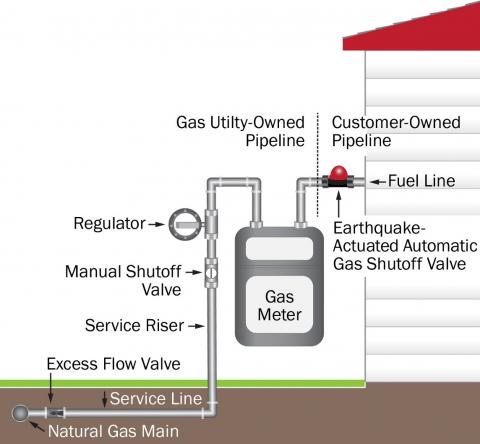
Types of Automatic Gas Shutoff Valves
All homes that take natural gas have a transmission shutoff valve located on the gas meter that tin exist closed using a wrench to stop the flow of natural gas into the home in the event of an emergency (Effigy 5). Nonetheless, the home's occupants may not be available to close the line in the result of a natural disaster or may non be enlightened of a rupture of the line due to some other cause such as digging. If an automated gas shutoff valve is installed on the line, it can stop the flow of gas speedily in the result of an emergency with no human intervention needed, preventing large gas spills from occurring and potentially causing fires or explosions.
In that location are 2 types of automatic gas close-off devices: earthquake-actuated gas shut-off valves (likewise known as seismic valves) and excess flow valves. The differences between the 2 valves are summarized in Table 1 and described beneath. Requirements for shutoff valves for natural gas lines vary by jurisdiction. The requirement typically applies to new building construction and significant alterations or additions to existing buildings (PG&E 2022). Considering an earthquake valve is triggered past movement, not an actual line suspension, while it volition prevent gas leakage from the initial quake or aftershocks, it will shut off the gas fifty-fifty if no rupture occurs to the gas line. In dissimilarity, an backlog period valve is triggered by sudden high flow on the line, indicating a leak has occurred; convulsion movement lone won't trigger information technology. Utilities notation that restoration of utility gas service after an emergency will take fourth dimension, whether the gas valve has been shut manually or automatically, because the utility may require that its crews inspect the gas meter and equipment to verify in that location are no leaks in the line, clear active lines of balance gas, restore service to the lines, and relight pilot lights (PG&E 2022).
| Earthquake Shutoff Valve | Excess Flow Valve | |
|---|---|---|
| How does it work? | Senses earthquakes and large ground move ≥ 5.4 on Richter Scale. | Senses gas leaks. |
| What does it practice? | Stops menstruum of gas on fuel line from meter into home at first sign of globe movement. | Stops period of gas on the service line betwixt the main line and the meter when it detects high gas flow and/or loss of line pressure depending on valve model. |
| What doesn't it do? | Won't stop gas flow for reasons other than earthquakes, such equally a line rupture due to excavation or a faulty apparatus. | Won't finish gas flow during an convulsion unless the gas line is severed. Won't stop menstruum of gas within your home due to puncture, small leak, or an appliance malfunction Won't completely cease the menses of gas; may allow a small amount through. |
| What triggers it? | Triggered by ground shaking, equivalent to about 5.four or greater on the Richter Scale. | Sensors on the gas line detect a big increase in gas menstruum charge per unit due to a rupture of the service line (for any crusade, such as earthquakes, tree roots, excavation equipment, severed line in firm) |
| Where is it located? | On the homeowner's side of the meter, unremarkably outside and to a higher place ground on the fuel line between the meter and the home. | On the utility side of the meter, underground, on the service line between the main line and the gas meter |
| Who installs? | Licensed plumber or homeowner | Utility or utility contractor. |
| Who pays for information technology? | Homeowner | Homeowner (sometimes utility pays in new construction) |
| Who is responsible for maintenance and replacement? | Homeowner | Utility |
| Cost | $100-$thousand | $200-$7,000 |
| Is information technology required? | Varies. Check local building code. | Required by Federal law on all new homes with gas since 2006 (or before in some jurisdictions). Bank check local requirements for existing homes. |
| Who resets? | Requires manual reset to restart flow of gas. Can exist reset by homeowner, or utility may crave reset by utility staff. | Automatically resets subsequently utility staff repairs the line. |
Earthquake-Actuated Gas Shutoff Valves
An earthquake-actuated gas shutoff valve (likewise known as an earthquake valve or a seismic valve) is a simple mechanical device installed just downstream of the meter on the pipe between the meter and the business firm (Figures 1 and 2). If the valve is subjected to significant movement, a ball or "bladder" in the valve drops into place to block the flow of gas through the pipe and into the building. If an convulsion does impact the dwelling, gas flow will be stopped past the valve so gas will not continue to period into the habitation, where it could potentially leak from any ruptures in the line downstream of the meter and peradventure catch fire or explode. Earth movement equivalent to an convulsion registering approximately 5.4 or greater on the Richter scale volition activate the locking mechanism. (The Richter calibration ranges from 1.5-barely detectable to 9.5-catastophic; a 5.4 quake could crusade considerable impairment.) Many utilities require the installer to attach a stabilizing subclass to the pipe almost the valve to minimize the likelihood that an accidental bump will actuate the valve.
Seismic valves tin can exist required by insurance companies or local departments of building and rubber in areas prone to seismic activity. Some urban center, land, and/or county regulations require the installation of seismic valves; some go out this upwardly to the owner'due south discretion. Seismic valves are typically located on the homeowner's side of the meter, on the pipeline leading from the meter into the house, which is usually located in an hands accessed location outside, above ground on the side or forepart of the house. The seismic valve is located downstream of the utility manual gas shut-off valve, pressure regulator, meter, and the service tee (meet Figures one and 2).

Seismic valves are purchased by the homeowner and installed by either the homeowner or a licensed plumber or contractor who has been certified to practice then. Most utilities practice not install seismic valves (for example, SoCalGas 2022). Some utilities offer aid in purchasing the valves. For instance, the Urban center of Berkeley, California, offers free seismic valves to homeowners who complete a training program (Metropolis of Berkeley 2022). The City of Malibu, California, requires a plumbing let to install valves but waives fees for the permit process (Urban center of Malibu). Utilities do not typically permit attachments or connections of whatsoever kind on the utility'southward piping and equipment before the betoken where the service tee connects to the gas houseline piping. Later on installation, the valve must non obstruct any gas operations or utility services in or around their piping, gas service shut-off valves, gas meters, or gas pressure regulating equipment (PG&East 2022).
Seismic valve products should meet the requirements of ASCE 25-97 and ANSI Z21.70-1981 Standards for Seismic Gas Valves. Some locales require that installers employ a state-approved model for excess menstruum gas shut-off valves and convulsion-actuated gas shut-off valves. Seismic valves installed in California should be certified by the California Land Architect's Role every bit meeting California Standard No. 12-23-1 for Earthquake-Actuated Automatic Gas Shut off Systems. The State of California's Division of the State Builder (DSA) oversees the certification of both types of gas shutoff valves as required by the Health and Rubber Code and lists canonical models on the website of the DSA Gas Shut-off Valves Certification Program. Products used in Los Angeles need to be approved by the City of Los Angeles. Examples of seismic valves canonical for utilize in California are shown in Figures iii and 4.
Seismic valves will operate to shut off the gas when they sense enough earth movement, whether a line rupture occurs or not. If the gas is shut off by a seismic valve, some utilities specify that the homeowner is not to turn the gas dorsum on themselves merely should notify the utility to accept a utility representative perform a safe check, restore gas service, and relight apparatus pilot lights. For this reason, some utilities do not encourage the installation of seismic shutoff valves for residential service due to the time required to become effectually and reset all of the valves post-obit an convulsion. Some jurisdictions require excess flow valves instead. Check the applicable jurisdiction for specific requirements in your surface area (FEMA E-74, 2022).
The valve is manually reset once a rubber inspection has been washed to verify there are no leaks in the building. Some jurisdictions let homeowners to reset their own automatic shutoff valves. This is one reason some homeowners adopt to have an convulsion-actuated shutoff valve even if not required to do so by the local building section or their homeowner'south insurance company. In the issue of an earthquake, an convulsion-actuated valve will shut off gas period as shortly equally significant globe motility is detected without waiting to sense a gas leak. If, later the quake, no leaks are detected, the homeowner may be able to reset the valve or rent a plumber to reset the valve and re-establish gas service. Many homes have both types of valves.
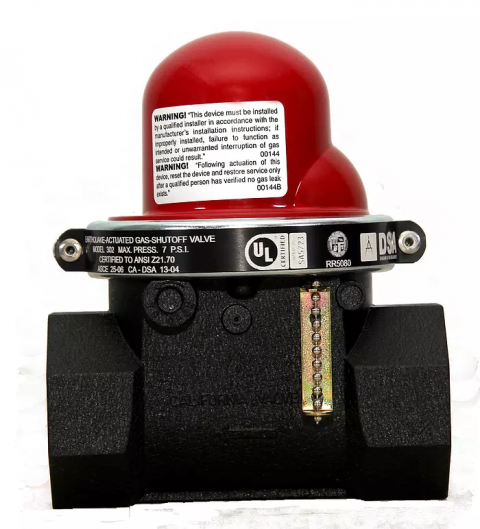

Excess Catamenia Valves
Excess flow valves automatically stop the flow of gas on the service line betwixt the main gas line at the street and the client's meter (on the "utility side" of the meter) if backlog menstruation or loss of pressure is detected, indicating a rupture of the gas line (American Gas Association 2022), whether the rupture is acquired by an earthquake, or some other natural cause such as a sinkhole or a washout, or damage from digging or drilling equipment, or motor vehicle impact to the meter, or line breakage in the abode.
In 2006, Congress mandated the employ of excess flow valves on all new or replaced gas distribution lines serving unmarried-family unit residences (49 CFR 192.383(a)). By the terminate of 2022, an estimated 9 million excess flow valves were in service and over 800,000 new valves were being installed every year (P&GJ 2022). In a Last Rule published in the Federal Register on October 14, 2022, the Pipeline and Hazardous Materials Safety Administration (PHMSA) fabricated changes to 49 CFR Role 192 to expand the requirement to include multifamily residences and small commercial buildings, and required gas utilities to notify customers who had existing homes without excess flow valves of their right to request installation of one. For new homes, the price of installation is included in the charge for the new line.
Dates at which utilities began installing excess flow valves for new homes vary by utility, although many pre-date the 2006 Congressional mandate. For example, all homes with gas service built in Oregon after 1993 have an excess period valve installed by the utility at construction. With an existing dwelling, if you lot are unsure if an excess flow valve is already installed, contact the gas utility. In existing homes without an backlog menstruum valve, the customer can request that the utility install ane, at the homeowner's expense (Colorado Springs Utilities). The utility or their service contractor will install the excess flow valve on the hush-hush service line pipe running from the street to the meter. Costs vary depending on location and difficulty of the installation, with reported costs ranging from $400 to $7,000. For example, the Urban center of Ellensburg, Washington, estimates $500 to $grand (Urban center of Ellensburg). TECO Peoples Gas in Florida estimates $one,200 to $one,800 (TECO Peoples Gas). PG&E estimates $2,500 to $6,000 or more than, based on the specific site (PG&E 2022).
Some things to note about excess menstruum valves (EFVs) (KUB 2022):
- EFVs actuate simply if the gas service line is severed.
- EFVs do not activate if the gas service line has only a minor puncture or a small leak.
- EFVs do not protect against household appliance malfunctions.
- EFVs do non foreclose leaks.
- EFVs do not operate on all gas service lines (for example very depression-force per unit area or high-volume lines).
How to Manually Turn Off the Gas at the Main Shutoff Valve
In an emergency, some utilities tell their homeowners that the gas can exist turned off at the principal gas service shutoff valve, with the following guidelines (for example, PG&E 2022, SoCalGas 2022).
- Do not shut off the gas unless you scent gas, hear gas escaping, see a broken gas line, suspect a gas leak, or are advised to practise and so by the gas utility. If yous shut off the gas, there may be a considerable delay before the utility can plow your service back on.
- Locate the master gas shutoff valve. Information technology is typically adjacent to the gas meter. It may be on the side of front end of the house, or in a cabinet meter outside of the business firm, under the business firm, or clandestine.
- Have a wrench handy. Go on a 12- to 15-inch adjustable pipage or crescent-type wrench in a known location. It may not exist appropriate to go along it visible side by side to the meter where someone might use information technology to tamper with the meter.
- Give the valve a quarter turn in either direction. The valve is closed when the tang (the part of the valve you put the wrench on) is crosswise (perpendicular) to the pipe. Encounter Figures 5 and 6.
Note, some jurisdictions and gas utility companies stipulate that manual gas shut-off can simply be performed by the utility or its certified contractors (California Public Utilities Commission General Social club 112-Due east).

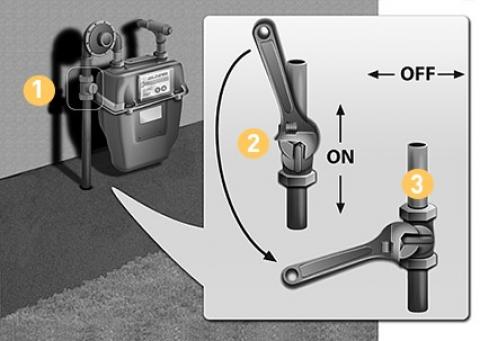
How to Manually Turn Off the Gas to Each Natural Gas Appliance
In the event of a overflowing, earthquake, tornado, or wildfire, some utilities propose homeowners, if they can safely do so, to
- Plow off all gas appliances.
- Manually plow off the gas shutoff valve at each apparatus. For rubber, a shut-off valve should exist installed at every natural gas appliance. If a leak happens at a specific appliance, the valve allows y'all to turn off the natural gas at the appliance rather than shutting off the natural gas service line to the whole house. Some valves require a wrench. See Figure vii.
- If you can't close off gas to an appliance, plow off the gas at the gas service shutoff valve, typically located virtually the gas meter.
- Consult your local utility for guidance. Some utilities advise homeowners not to shut off the gas unless they odour gas, hear gas escaping, meet a broken gas line, or suspect a gas leak because, if they practice shut off the gas, at that place may be a considerable delay before the utility can turn the service back on (for example, PG&Eastward).
Later on a alluvion or other natural disaster, some utilities recommend the following to homeowners (for example, NW Natural Gas, PG&E, SoCalGas).
- Do not turn your gas dorsum on if it has been turned off at the meter. Call for a gas utility technician to come out.
- Practice non try to utilise a flooded meter or whatsoever gas equipment.
- Call the gas utility to reactivate the equipment and meter.
- Wait for an inspection by a qualified licensed HVAC technician or plumber earlier using whatsoever gas equipment that has been submerged.
- Let the gas company's service technician check the equipment, open the gas line, and re-light airplane pilot lights.
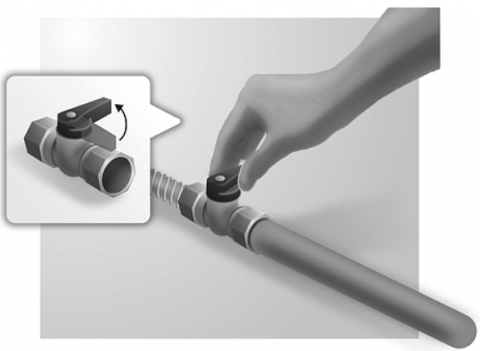
How to Plow off the Electricity
Some utilities recommend turning off electricity to the home before a predicted natural disaster upshot, or prior to evacuating, if safe to do and then. Consult your local utility for guidance. Plow off the electrical supply to the entire household at the master electric switch located on the electric panel. Never impact the electric switch or circuit breaker with moisture hands or while standing in h2o (PG&E).
Ensuring Success
Some city, county, and state regulations require the installation of automatic gas shut-off devices. There are ii types of automatic gas shut-off devices: earthquake-actuated gas close-off valves (also known as seismic valves) and excess flow valves. Convulsion/seismic valves should be installed by a licensed plumber. The Country of California requires that seismic automatic gas shut-off valves exist certified past the state and installed by a licensed plumbing contractor in accordance to the manufacturer'due south instructions. Your municipality may require one or the other or both. The requirement typically applies to new building structure and significant alterations or additions to existing buildings. Check with your local city or county building department and your gas utility to see what is required and immune in your location.
Climate
Propose homeowners to know the disasters likely to occur in the domicile'due south location and to consult with their utilities or utility websites regarding what to exercise virtually gas and electrical service during those disasters earlier a disaster strikes.
Show homeowners where the gas valves are on each gas or propane appliance installed and where the main gas valve is located (likely outside of the home upstream of the meter) and explain how to turn it off. As well prove the homeowner where the electrical console is and the main switch on the panel.
Earthquakes
Figure 1 shows the probability of an earthquake occurring in diverse locations in the Us. Because earthquakes can strike at any time without warning, in locations prone to earthquakes, some municipalities require seismic gas shutoff valves and/or excess flow valves. Seismic gas shutoff valves shut off the catamenia of gas from the meter to the house if world move equivalent to nigh 5.4 or more than on the Richter calibration is detected. Excess menstruum valves stop the menses of gas in the service line from the street to the meter if backlog catamenia or loss of pressure is detected indicating a potential rupture of the gas line for whatever reason. Whether required or not, homeowners may wish to install either or both valves. Check with the local lawmaking authority and gas utility to see what is required or allowed and follow the guidance given in the Clarification tab of this guide.
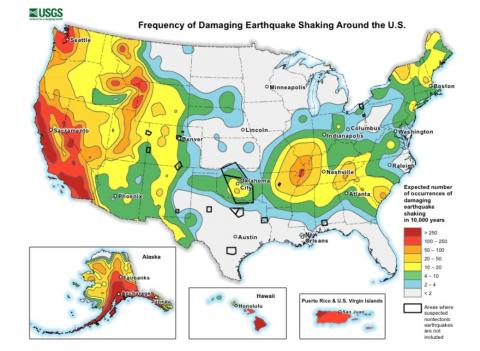
Wildfires
Prove homeowners how to access and close the individual valves on all gas and propane appliances (IBHS) and where to manually plough off the master valve if directed to do so by their utility.
Floods or Hurricanes
Some utilities recommend that homeowners manually shut off the gas at the meter if flood waters are likely to rise above the level of the gas meter or appliances (NW Natural Gas).
In the upshot of an expected flood, some utilities advise homeowners to:
- Turn off all gas appliances.
- Manually plough off the gas shutoff valve at each appliance.
- If you can't shut off gas to an apparatus, turn off the gas at the gas service shutoff valve typically located near the gas meter.
After a flood, some utilities recommend the following to homeowners (for instance, NW Natural Gas, PG&East, SoCalGas):
- Exercise not turn your gas back on if it has been turned off at the meter. Call for a gas utility technician to come out.
- Do not try to utilize a flooded meter or any gas equipment.
- Call the gas utility to reactivate the equipment and meter.
- Wait for an inspection by a qualified licensed HVAC technician or plumber before using any gas equipment that has been submerged.
- Let the gas company's service technician bank check the equipment, open the gas line, and relight pilot lights.
The Compliance tab contains both program and lawmaking information. Code language is excerpted and summarized beneath. For exact code language, refer to the applicative code, which may require purchase from the publisher. While we continually update our database, links may have changed since posting. Please contact our webmaster if you find cleaved links.
2009, 2022, 2022, 2018, and 2021 International Residential Lawmaking (IRC)
Chapter 24 Fuel Gas Section G2420.
G2420.2 (409.two) Meter Valve. Every meter shall exist equipped with a shutoff valve located on the supply side of the meter.
G2420.3 (409.3.2) Private Buildings. In a common system serving more than one building, shutoff valves shall exist installed outdoors at each building.
G2420.iv (409.four) MP Regulator Valves. A listed shutoff valve shall be installed immediately ahead of each MP [medium pressure] regulator.
G2420.5 (409.5) Apparatus Shutoff Valve. Each appliance shall exist provided with a shutoff valve in accordance with Section G2420.v.one, G2420.5.ii or G2420.5.three.
G2420.v.1 (409.5.one) Located Within Same Room. The shutoff valve shall be located in the same room every bit the appliance. The shutoff valve shall be within 6 feet (i,829 mm) of the apparatus, and shall exist installed upstream of the union, connector or quick disconnect device information technology serves. Such shutoff valves shall exist provided with access. Shutoff valves serving movable appliances, such as cooking appliances and clothes dryers, shall exist considered to be provided with access where installed behind such appliances. Apparatus shutoff valves located in the firebox of a fireplace shall be installed in accordance with the apparatus manufacturer's instructions.
G2420.5.three (409.five.3) Located at Manifold. Where the appliance shutoff valve is installed at a manifold, such shutoff valve shall be located within fifty anxiety (15,240 mm) of the appliance served and shall exist readily accessible and permanently identified. The piping from the manifold to within 6 feet (one,829 mm) of the apparatus shall be designed, sized and installed in accord with Sections G2412 through G2419.
G2420.vi (409.7) Shutoff Valves in Tubing Systems. Shutoff valves installed in tubing systems shall be rigidly and securely supported independently of the tubing.
Retrofit: 2009, 2022, 2022, 2022, and 2022 IRC
Section R102.7.1 Additions, alterations, or repairs. Additions, alterations, renovations, or repairs shall suit to the provisions of this code, without requiring the unaltered portions of the existing building to comply with the requirements of this lawmaking, unless otherwise stated. (See lawmaking for boosted requirements and exceptions.)
Appendix J regulates the repair, renovation, alteration, and reconstruction of existing buildings and is intended to encourage their connected safety employ.
NFPA 54/ANSI Z223.1: National Fuel Gas Lawmaking
Code providing minimum safety requirements for the blueprint and installation of fuel gas piping systems in homes and other buildings.
State of California:
Country of California Department of Consumer Affairs Contractors Land License Board
C-36 – Plumbing Contractor: California Code of Regulations Title xvi, Segmentation viii, Commodity 3 Classifications. Plumbing contractors in the Land of California must receive the C-36 Plumbing Contractor License to install gas earthquake valves.
State of CA Plumbing Code 2022
For a list of earthquake-actuated automatic gas shutoff valves certified to meet 2022 California Plumbing Code Standards, yous may consult the 2022 DSA Certified ESV List (California DGS).
Department 1208.13 Shutoff Valves. Shutoff valves shall be approved and shall be selected giving consideration to pressure drop, service involved, emergency use, and reliability of operation. Shutoff valves of size 1 inch (25 mm) National Pipe Thread and smaller shall be listed [NFPA 54:five:12]
Section 1210.11.two Emergency Shutoff Valves. An outside shutoff valve to permit turning off the gas supply to each building in an emergency shall be provided. The emergency shutoff valves shall be plainly marked as such and their locations posed as required by the Authoring Having Jurisdiction (NFPA 54:vii.nine.2.3).
Department 1210.18 Earthquake-Actuated Gas Shutoff Valves. Convulsion-actuated gas shutoff valves, certified by the Land Architect as conforming to California Referenced Standards Code (CRSC), Standard 12-12-1, shall exist provided for buildings when such installation is required past local ordinance. Earthquake-actuated gas shutoff valves which have not been certified by the State Builder shall be prohibited in buildings open up to the public under mandatory installation by local ordinance. An earthquake-actuated gas shutoff valve is a valve for installation in a gas piping system and designed to automatically close off the gas at the location of the valve in the event of a seismic disturbance.
Section 1211.5 [manual] Appliance Shutoff Valves and Connections. Appliances connected to a piping system shall have an attainable approved manual shutoff valve with a nondisplaceable valve fellow member, or a listed gas convenience outlet installed within 6 anxiety of the appliance it serves.
Section 1209.1 Excess Menstruum Valve. General. Where automatic excess flow valves are installed, they shall exist listed, sized, and installed in accordance with the manufacturer's installation instructions. [NFPA 54.5.thirteen]
Code of Federal Regulations
49 CFR 192.383 High Volume Excess Menses Valves
Backlog Menses Valves (EFVs) are condom devices installed on natural gas distribution pipelines to reduce the risk of accidents. EFVs are required for new or replaced gas service lines servicing single-family residences (SFR), as that phrase is defined in 49 CFR 192.383(a). Following the investigation of a natural gas explosion in Loudon County, Virginia, in 1998, the National Transportation Safety Board (NTSB) recommended (Recommendation P-01-002) that the Pipeline and Chancy Materials Safety Assistants (PHMSA) crave that backlog flow valves be installed in all new and renewed gas service lines, regardless of a customer's classification, when the operating weather are compatible with readily available valves.
In a Final Dominion published in the Federal Register on Oct 14, 2022, PHMSA made changes to 49 CFR Office 192 to expand the requirement for EFVs to include new or replaced branched service lines servicing unmarried-family unit residences, multifamily residences, and pocket-sized commercial entities consuming gas volumes not exceeding 1,000 standard cubic feet per hour (SCFH). PHMSA also amended Office 192 to require the utilize of either manual service line shut-off valves (e.g., curb valves) or EFVs, if appropriate, for new or replaced service lines with meter capacities exceeding 1,000 SCFH. This final rule also requires operators to notify customers of their right to asking installation of EFVs on service lines that are not beingness newly installed or replaced. PHMSA left the question of who bears the toll of installing EFVs on service lines not being newly installed or replaced to the operator's rate-setter. This concluding dominion, entitled "Expanding the Use of Excess Flow Valves in Gas Distribution Systems to Applications Other Than Unmarried-Family unit Residences," is effective Apr 14, 2022.
Existing Homes
On existing homes in earthquake-prone regions, if an earthquake-actuated automated gas shutoff valve is desired past the homeowner or required by local code, follow the guidance in the Description tab for selecting and installing the valve on the fuel line on the house side of the meter.
Consult with the utility to run into if an excess menstruation valve has already been installed on the clandestine service line going from the natural gas main line to the meter. If none has been installed and the homeowner desires or is required by local ordinance to have one installed, they tin can request one from the utility and the utility will install the excess flow valve at the homeowner'southward expense.
Admission to some references may require purchase from the publisher. While nosotros continually update our database, links may have changed since posting. Please contact our webmaster if you find cleaved links.
References and Resource*
*For non-dated media, such as websites, the engagement listed is the date accessed.
Contributors to this Guide
The following authors and organizations contributed to the content in this Guide.
Pacific Northwest National Laboratory
Mobile Field Kit
The Building America Field Kit allows you to save items to your profile for review or utilise on-site.
Sign Up or Log In
Did y'all notice this data helpful?
Source: https://basc.pnnl.gov/resource-guides/automatic-gas-shutoff-valves
Posted by: cannadygles1968.blogspot.com


0 Response to "How To Install Automatic Gas Shut Off Valve"
Post a Comment